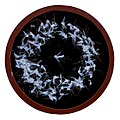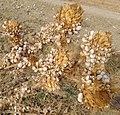Category:Swarming
Jump to navigation
Jump to search
Azərbaycanca: Sürü:
Български: Пасаж е група риби от един и същ биологичен вид, по изключение и повече от един вид, които се придвижват заедно и се хранят заедно. Тези риби плуват в голяма степен успоредно една на друга, на едно и също разстояние в една и съща посока. Рибите могат да плуват през цялата година, сезонно или само при определна причина (природно бедствие).
Català: Una mola de peixos, és un conjunt dens de peixos similars, nedant amb una alta sincronització i de manera polaritzada.
Dansk: Begrebet sværm, stime eller flok bruges om fisk, fugle og insekter med en adfærd, hvor et stort antal dyr af ensartet størrelse bevæger sig i samme retning.
Deutsch: Der Begriff Schwarmverhalten bezeichnet das Verhalten von Fischen, Vögeln, Insekten oder anderen Tieren, sich zu Aggregationen von Individuen – meist gleicher Art und Größe – zusammenzuschließen. Oft bewegen sie sich gemeinsam in eine Richtung. Es können sich jedoch auch Mischschwärme aus Tieren unterschiedlicher Arten und Größe bilden. Vorteile der Schwarmbildung ergeben sich bei der Nahrungssuche und im Schutz vor möglichen Fressfeinden, z. B. durch kollektive Wachsamkeit. Typische Schwarmtiere sind beispielsweise Heringe, Stare und Wanderheuschrecken. Die physiologische Basis, die es den Individuen eines Schwarm ermöglicht, sich in der beobachtbaren Synchronizität zu bewegen, wird in den Spiegelneuronen vermutet.
English: Swarm behaviour, or swarming, is a collective behaviour exhibited by animals of similar size which aggregate together, perhaps milling about the same spot or perhaps moving en masse or migrating in some direction. As a term, swarming is applied particularly to insects, but can also be applied to any other animal that exhibits swarm behaviour. The term flocking is usually used to refer specifically to swarm behaviour in birds, herding to refer to swarm behaviour in quadrupeds, shoaling or schooling to refer to swarm behaviour in fish. Phytoplankton also gather in huge swarms called blooms, although these organisms are algae and are not self propelled the way animals are. By extension, the term swarm is applied also to inanimate entities which exhibit parallel behaviours, as in a robot swarm, an earthquake swarm, or a swarm of stars.
Esperanto: Birdaro estas grupo de birdoj kiuj sekvas ariĝan konduton dumfluge aŭ dum manĝado. La termino similas al grego inter mamuloj. Profito de ariĝo varias kaj la aroj kaj formoj de ariĝo okazas por specifaj celoj. Ariĝo ankaŭ kostas, ĉefe ĉe socie subulaj birdoj, kiu estas ĉikanataj de hegemoniaj birdoj; birdaraj birdoj povas ankaŭ malprofiti je manĝefiko ŝanĝe al akiri aliajn profitojn. Ĉefa profito estas sekureco laŭ nombroj kaj plialtigita mangefiko. Defendo kontraŭ predantoj gravegas ĉe fermitaj habitatoj kiaj arbaroj kie predado oftas kaj ĉefe averto havigita de multaj okuloj gravas; tio estas kialo por disvolvigo de miksitaj kunmanĝantaroj. Tiuj multaspeciaj aroj estas kutime komponitaj de malgrandaj nombroj de multaj specioj, pliigante la profitojn pro nombro sed malpliigante la manĝodisponeblon.
Español: Un enjambre (del latín exāmen, -ĭnis) es un conjunto de insectos similares, principalmente de abejas (gramaticalmente, es el número gramatical o colectivo de éstos).
Eesti: Parv on ühe loomaliigi isenditest moodustunud ajutine koos liikuv kogum. Enamasti kasutatakse mõistet kas lendavate (näiteks linnud, putukad) või ujuvate loomade (kalade) puhul.
Suomi: Kalojen parvikäyttäytyminen tarkoittaa kalojen käyttäytymispiirrettä, jossa vapaasti uivat kalat pyrkivät kasaantumaan tiiviiksi ryppääksi. Tyypillistä parvikäyttäytymisessä on kalojen uiminen yhdensuuntaisesti ja samanaikaisin liikkein.
Français : Un essaim est un rassemblement en nombre important d'insectes de la même famille. Le phénomène dit de « nuée » ou « tempête d'insectes » n'a pas d'origine météorologique directe mais est saisonnier et est lié aux épisodes de sécheresse et de pluie qui font varier la quantité de nourriture disponible pour les insectes. Il se produit lorsqu'une certaine population d'insectes (par exemple des sauterelles ou des criquets) qui s'est massivement reproduite dans un lieu humide, initialement favorable à son développement, ne parvient plus à subvenir à ses besoins alimentaires. L'essaim se produit plus rarement avec des coccinelles ou des mouches. Des nuages denses de certains papillons migrateurs pouvaient évoquer un tel phénomène, donnant une impression de tempête de neige au passage des cols (par exemple dans les Pyrénées) ou dans certaines vallées d'Europe, ou avec le monarque américain là où ses vols étaient particulièrement denses.
Italiano: Il termime stormo, equivalente a branco per i mammiferi, si riferisce ad un gruppo di uccelli che si riuniscono assieme durante il volo o mentre si nutrono.
Nederlands: Een zwerm is een groep insecten, vogels of vleermuizen, die schijnbaar als één groep bewegen, vergelijkbaar met een school vissen.
Polski: Ławica ryb – tymczasowa grupa ryb pływających razem w celu zapewnienia sobie pokarmu i większego bezpieczeństwa.
Português: Um cardume é o substantivo colectivo que designa um grupo de peixes, normalmente da mesma espécie e do mesmo grupo etário, que nadam como se fossem um único indivíduo.
Русский: Стая — системная целостность, структурированная группа млекопитающих, рыб или птиц, обычно одного вида, находящихся в сходном биологическом состоянии, активно поддерживающих взаимный контакт и координирующих свои действия; стая состоит из особей, которые выполняют ряд важных жизненных функций, будучи членами той или иной стаи на протяжении большой части своей жизни. Существует мнение, что именно стая (а не стадо) первобытных протолюдей послужила основой создания человеческого социума.
Simple English: A swarm is a big group of animals. The term is usually used for insects, but other animals such fish and birds can make a swarm also. A good example of animals that swarm are locusts. Mammals do not build swarms, but herds.
Slovenščina: Játa je pojav iz živalskega sveta, ki označuje združevanje več osebkov iste vrste z namenom prehranjevanja, selitve ali varnosti. Izraz se najpogosteje uporablja pri pticah in ribah. Pri žuželkah se za ta pojav uporablja izraz roj, pri sesalcih pa trop ali čreda.
ChiShona: Bumha (swarm of insects) zvinoreva kuwungana kwezvinhu zvidiki zvakafanana. Somuenzaniso kune bumha re nyuchi kana bumha remago.
Српски / srpski: Јато означава већу групу птица у лету или групу риба док пливају. За птице или рибе у јату се обично подразумева да су у лету (пливању) поређане једна за другом у специфичном облику погодном за дужи лет (пливање). Овај појам се најчешће користи за птице селице (роде и ласте) када у јату лете из хладнијих предела у топлије или се враћају из топлијих крајева по завршетку зиме. Такође, јато означава и групу појединих сисара; слепих мишева, као и делфина и других водених сисара.
Svenska: Svärm är en typ av flockbeteende där individerna i högre grad än i ett stim följer varandra, med högre hastighet och intensitet. Inuti svärmen tycks varje enskild individs rörelser vara kaosartade, men utifrån sett beskriver de en sammanhängande form. Flockens beteende som svärm är övergående. Främst används uttrycket om insekter, exempelvis om svärmande bin, men förekommer ibland i överförd betydelse om andra företeelser, exempelvis i datorsammanhang.
Українська: Зграя — системна цілісність, структурована група ссавців, риб або птахів, зазвичай одного виду, що знаходяться в схожому біологічному стані, активно підтримують взаємний контакт і що координують свої дії; зграя складається з особин, які виконують ряд важливих життєвих функцій, будучи членами тієї або іншої зграї впродовж більшої частини свого життя.
swarming behaviour of birds when flying or foraging | |||||
| Upload media | |||||
| Subclass of |
| ||||
|---|---|---|---|---|---|
| Said to be the same as | Q97382392 | ||||
| Partially coincident with | |||||
| |||||
Subcategories
This category has the following 8 subcategories, out of 8 total.
Media in category "Swarming"
The following 45 files are in this category, out of 45 total.
-
AbelhasDSC8522.jpg 1,765 × 2,584; 2.42 MB
-
Bacillus subtilis swarm.JPG 2,048 × 1,536; 877 KB
-
Bees gather on residential fence posts 01.jpg 2,048 × 1,365; 2.06 MB
-
Bees gather on residential fence posts 02.jpg 2,048 × 1,365; 1.19 MB
-
Bees gather on residential fence posts 03.jpg 2,048 × 1,365; 1.14 MB
-
Bees gather on residential fence posts 04.jpg 2,048 × 1,365; 1.87 MB
-
Bees gather on residential fence posts 05.jpg 2,048 × 1,365; 1.27 MB
-
Bees gather on residential fence posts 06.jpg 2,048 × 1,365; 827 KB
-
Bees gather on residential fence posts 07.jpg 2,048 × 1,365; 1.79 MB
-
Bees gather on residential fence posts 08.jpg 2,048 × 1,598; 2.19 MB
-
Collective-Motion-of-Spherical-Bacteria-pone.0083760.s003.ogv 9.5 s, 640 × 652; 5.74 MB
-
Collective-Motion-of-Spherical-Bacteria-pone.0083760.s004.ogv 9.1 s, 432 × 500; 17.29 MB
-
Collective-Motion-of-Spherical-Bacteria-pone.0083760.s005.ogv 9.7 s, 432 × 500; 7.56 MB
-
DA Fig3.gif 537 × 482; 460 KB
-
DA Reynold.png 775 × 517; 87 KB
-
Expo Ballonrelease.jpg 4,172 × 2,378; 7.84 MB
-
Flying ants in London.webm 40 s, 1,920 × 1,080; 14.85 MB
-
Groupe d'oiseaux aquatiques du Lac Kinkony, Boeny, Madagascar.jpg 3,872 × 2,592; 4.04 MB
-
Hemimysis anomala swarm.jpg 400 × 360; 34 KB
-
Highland midge (Culicoides impunctatus) swarm biting me!.webm 25 s, 3,413 × 1,920; 7.88 MB
-
Human Swarm.gif 925 × 715; 4.73 MB
-
Krill swarm.jpg 1,732 × 1,188; 1.22 MB
-
Leopard Frogs Sand Lake WMD (14635659718).jpg 3,216 × 2,136; 2.62 MB
-
Live Prenolepis imparis queen showing size.jpg 4,160 × 2,340; 897 KB
-
Logo of Unanimous AI.png 360 × 205; 15 KB
-
ParticleSwarmArrowsAnimation.gif 560 × 420; 4.67 MB
-
ParticleSwarmOptimizationAnimation.gif 560 × 420; 563 KB
-
Prenolepis imparis king and queen showing size.jpg 4,160 × 2,340; 921 KB
-
Red crab teknaf.jpg 5,472 × 3,648; 12.22 MB
-
Rojení včel.webm 1 min 10 s, 1,077 × 606; 17.65 MB
-
Sales Forecasting Example.gif 1,427 × 596; 871 KB
-
SEM flock particles.png 338 × 270; 104 KB
-
Snailfest - Flickr - gailhampshire.jpg 2,269 × 2,169; 1 MB
-
Stare in der Lehmgrube Marloffstein, 29,3,2019.webm 15 min 38 s, 1,920 × 1,080; 1.93 GB
-
Swarm (reference diagram).jpg 637 × 489; 56 KB
-
Swarm AI (clients).gif 1,214 × 646; 1.87 MB
-
Swarm of Bacillus subtilis on Agar with B-medium.jpeg 1,708 × 1,088; 285 KB
-
Swarm of bees on vacation.jpg 1,600 × 1,200; 623 KB
-
SWARM-vs-guerilla.png 1,227 × 830; 31 KB
-
Swarming growth of Proteus on blood agar.jpg 4,160 × 2,340; 3.26 MB
-
Swarming of bacteria.jpg 340 × 220; 25 KB
-
The honey bee (Page 104) BHL22273948.jpg 2,418 × 4,322; 840 KB
-
Voisinage d'un boid.png 1,123 × 794; 57 KB





































